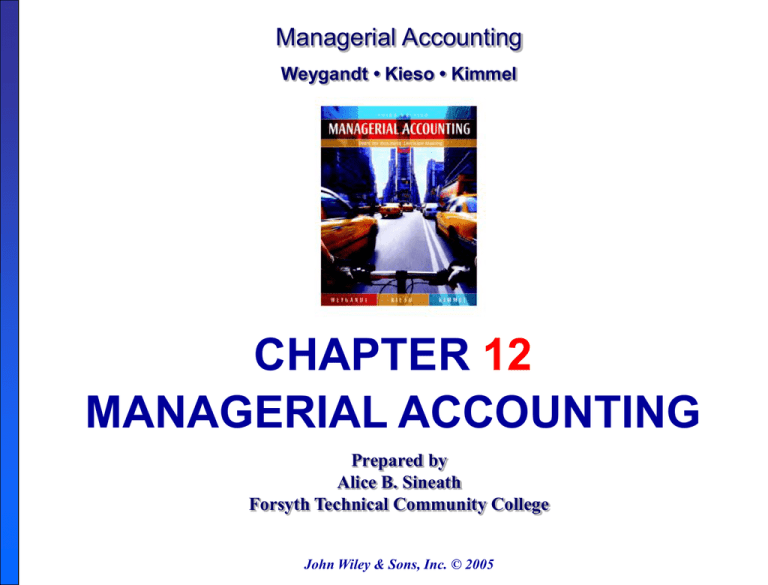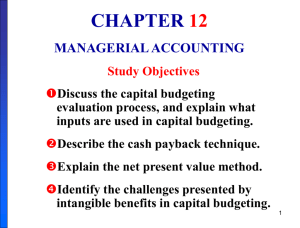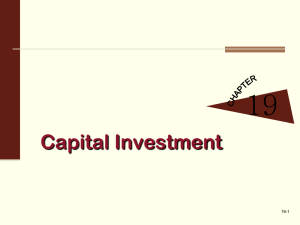
Managerial Accounting
Weygandt • Kieso • Kimmel
CHAPTER 12
MANAGERIAL ACCOUNTING
Prepared by
Alice B. Sineath
Forsyth Technical Community College
John Wiley & Sons, Inc. © 2005
CHAPTER 12
MANAGERIAL ACCOUNTING
Study Objectives
Discuss the capital budgeting
evaluation process, and explain what
inputs are used in capital budgeting.
Describe the cash payback technique.
Explain the net present value method.
Identify the challenges presented by
intangible benefits in capital budgeting.
Study Objectives: Continued
Describe the profitability
index.
Indicate the benefits of
performing a post-audit.
Explain the internal rate of
return method.
Describe the annual rate of
return method.
Capital Budgeting
Evaluation Process
Study Objective 1
Many companies follow a carefully
prescribed process in capital
budgeting. At least once a year:
1) Proposals for projects are requested
from each department.
2) The proposals are screened by a capital
budgeting committee, which submits its
finding to officers of the company.
3) Officers select projects and submit list of
projects to the board of directors.
Capital Budgeting
Evaluation Process
The capital budgeting decision depends
depends on a variety of considerations:
1) The availability of funds.
2) Relationships among proposed
projects.
3) The company’s basic decision-making
approach.
4) The risk associated with a particular
project.
Cash Payback Formula
Study Objective 2
The cash payback technique identifies the time period
required to recover the cost of the capital investment from
the annual cash inflow produced by the investment.
The formula for computing the cash payback period is:
Estimated Annual Net
Income from Capital
Expenditure
Assume that Reno Co. is considering an investment of $130,000 in new
equipment. The new equipment is expected to last 5 years. It will have
zero salvage value at the end of its useful life. The straight-line method
of depreciation is used for accounting purposes. The expected annual
revenues and costs of the new product that will be produced from the
investment are: (Text Illustration 12-25)
Computation of Annual Cash
Inflow
Cash income per year equals net income plus depreciation
expense.
Annual (or net) cash inflow is approximated by taking net income and adding
back depreciation expense. Depreciation expense is added back because
depreciation on the capital expenditure does not involve an annual outflow
of cash.
Net income
Add: Depreciation expense
Cash income
$13,000
26,000
$39,000
Cash Payback Period
The cash payback period in this example is
therefore 3.33 years, computed as follows:
$130,000
÷
$39,000
=
3.33 years
When the payback technique is used to decide among acceptable
alternative projects, the shorter the payback period, the more
attractive the investment. This is true for two reasons:
1) the earlier the investment is recovered, the sooner the cash
funds can be used for other purposes, and
2) the risk of loss from obsolescence and changed economic
conditions is less in a shorter payback period.
A $100,000 investment with a zero scrap value has an
8-year life. Compute the payback period if straight-line
depreciation is used and net income is determined to
be $20,000.
a. 8.00 years.
b. 3.08 years.
c. 5.00 years.
d. 13.33 years.
A $100,000 investment with a zero scrap value has an
8-year life. Compute the payback period if straight-line
depreciation is used and net income is determined to
be $20,000.
a. 8.00 years.
b. 3.08 years.
c. 5.00 years.
d. 13.33 years.
Net Present Value Method
Study Objective 3
• The present value method technique is
generally recognized as the best
conceptual approach to making capital
budgeting decisions.
• This technique considers both the
estimated total cash inflows and the
time value of money.
• Two methods are used with the
discounted cash flow technique:
1) net present value and
2) internal rate of return
Net Present Value Method
• Under the net present value method, cash
inflows are discounted to their present value
and then compared with the capital outlay
required by the investment.
• The interest rate used in discounting the
future cash inflows is the required minimum
rate of return.
• A proposal is acceptable when NPV is zero
or positive.
• The higher the positive NPV, the more
attractive the investment.
Net Present Value
Decision Criteria
Present Value of Annual
Cash Inflows-Equal Annual
Cash Flows
Stewart Soup Company’s annual cash inflows are $24,000. If we
assume this amount is uniform over the asset’s useful life, the
present value of the annual cash inflows can be computed by
using the present value of an annuity of 1 for 10 periods. The
computations at rates of return of 12% and 15%, respectively are:
Computation of Net Present
Values
The analysis of the proposal by the net
present value method is as follows:
The proposed capital expenditure is acceptable at a required rate of
return of both 12% and 15% because the net present values are positive.
Present Value of Annual Cash InflowsUnequal Annual Cash Flows
When annual cash inflows are unequal, we cannot use annuity tables to calculate their
present value. Instead tables showing the present value of a single future amount must be
applied to each annual cash inflow.
Year
1
2
3
4
5
6
7
8
9
10
Assumed
Annual
Cash Inflows
(1)
$36,000
32,000
29,000
27,000
26,000
24,000
23,000
22,000
21,000
20,000
$260,000
Discount Factor
12%
(2)
.89286
.79719
.71178
.63552
.56743
.50663
.45235
.40388
.36061
.32197
15%
(3)
.86957
.75614
.65752
.57175
.49718
.43233
.37594
.32690
.28426
.24719
Present Value
12%
(1) x (2)
$32,143
25,510
20,642
17,159
14,753
12,159
10,404
8,885
7,573
6,439
15%
(1) x (3)
$31,305
24,196
19,068
15,437
12,927
10,376
8,647
7,192
5,969
4,944
$155,667
$140,061
Analysis of Proposal Using
Net Present Value Method
Therefore, the analysis of the proposal by
the net present value method is as follows:
Present value of future cash inflows:
Capital investment
Positive (negative) net present value
12%
$155,667
15%
$140,061
130,000
130,000
$ 25,667
$10,061
In this example, the present values of the cash inflows
are greater than the $130,000 capital investment. Thus
the project is acceptable at both a 12% and 15%
required rate of return.
Compute the net present value of a $260,000
investment with a 10-year life, annual cash inflows of
$50,000 and a discount rate of 12%.
a. $(9,062).
b. $22,511.
c. $9,062.
d. $(22,511).
Compute the net present value of a $260,000
investment with a 10-year life, annual cash inflows of
$50,000 and a discount rate of 12%.
a. $(9,062).
b. $22,511.
c. $9,062.
d. $(22,511).
Additional Considerations
Study Objective 4
• The previous NPV example relied on
tangible costs and benefits that can be
relatively easily quantified.
• By ignoring intangible benefits, such
as increased quality, improved safety,
etc. capital budgeting techniques
might incorrectly eliminate projects
that could be financially beneficial to
the company.
Additional Considerations
To avoid rejecting projecting that
actually should be accepted, two
possible approaches are suggested:
1. Calculate net present value ignoring
intangible benefits. Then, if the NPV
is negative, ask whether the
intangible benefits are worth at least
the amount of the negative NPV.
2. Project rough, conservative
estimates of the value of the
intangible benefits, and incorporate
these values into the NPV calculation.
Describe the profitability index.
Study Objective 5
Present Value of Net Cash
Flows
÷
Initial Investment
Project A
Present Value
of Net Cash
Flows
Initial
Investment
Profitability
Index
=
Profitability
Index
Project B
$58,112
$110,574
$40,000
$90,000
1.45
1.23
Profitability Index
• In the previous slide, the profitability
index of Project A exceeds that of
Project B.
• Thus, Project A is more desirable.
• If the projects are not mutually
exclusive, and if resources are not
limited, then the company should
invest in both projects, since both
have positive NPVs.
Assume Project A has a present value of net cash
inflows of $79,600 and an initial investment of
$60,000. Project B has a present value of net cash
inflows of $82,500 and an initial investment of
$75,000. Assuming the projects are mutually
exclusive, which project should management select?
a. Project B.
b. Project A or B.
c. Project A.
d. There is not enough data to answer the
question.
Assume Project A has a present value of net cash
inflows of $79,600 and an initial investment of
$60,000. Project B has a present value of net cash
inflows of $82,500 and an initial investment of
$75,000. Assuming the projects are mutually
exclusive, which project should management select?
a. Project B.
b. Project A or B.
c. Project A.
d. There is not enough data to answer the
question.
Post-Audit of Investment Projects
Study Objective 6
Performing a post-audit is important for
a variety of reasons.
1. If managers know that their estimates will be
compared to actual results they will be more likely to
submit reasonable and accurate data when making
investment proposals.
2. A post-audit provides a formal mechanism by which
the company can determine whether existing
projects should be supported or terminated.
3. Post-audits improve future investment proposals
because by evaluating past successes and failures,
managers improve their estimation techniques.
Internal Rate of Return Method
Study Objective 7
Formula for Internal Rate
of Return Factor
• The internal rate of return method finds the interest yield
of the potential investment.
• This is the interest rate that will cause the present value
of the proposed capital expenditure to equal the present
value of the expected annual cash inflows.
• Determining the true interest rate involves two steps:
STEP 1.Compute the internal rate of return factor using
this formula:
Internal Rate of Return
Method
The computation for the Stewart Soup Company,
assuming equal annual cash inflows is:
$244,371 ÷
$1000,000 =
2.44371
Internal Rate of Return
Method
STEP 2. Use the factor and the present value of an
annuity of 1 table to find the internal rate of return.
• The internal rate of return is found by locating the
discount factor that is closest to the internal rate of
return factor for the time period covered by the annual
cash flows.
• For Stewart Soup, the annual cash flows are expected
to continue for 3 years. In the table below, the
discount factor of 2.44371 represents an interest rate
of 11%.
Internal Rate of Return
Decision Criteria
The decision rule is: Accept the project when the internal
rate of return is equal to or greater than the required rate of
return. Reject the project when the internal rate of return is
less than the required rate.
Comparison of Discounted
Cash Flow Methods
• In practice, the internal rate of return and cash
payback methods are most widely used.
• A comparative summary of the two discounted cash
flow methods-net present value and internal rate of
return- is presented below:
Item
1. Objective
Net Present Value
Compute net
present value.
2. Decision rule If net present
value is zero or
positive, accept
the proposal; if
net present value
is negative, reject
the proposal.
Internal Rate of Return
Compute internal rate of
return.
If internal rate of return
is equal to or greater
than the minimum
required rate of return,
accept the proposal; if
internal rate of return is
less than the minimum
rate, reject the proposal.
A $60,000 project has net cash inflows for 10 years of
$9,349. Compute the internal rate of return from this
investment.
a. 8%.
b. 10%.
c. 9%.
d. 11%.
A $60,000 project has net cash inflows for 10 years of
$9,349. Compute the internal rate of return from this
investment.
a. 8%.
b. 10%.
c. 9%.
d. 11%.
Annual Rate of Return
Formula
Study Objective 8
• The annual rate of return technique is based on
accounting data. It indicates the profitability of
a capital expenditure. The formula is:
The annual rate of return is compared with its required
minimum rate of return for investments of similar risk.
This minimum return is based on the company’s cost of capital,
which is the rate of return that management expects to pay on
all borrowed and equity funds.
Formula for Computing
Average Investment
Expected annual net income ($13,000) is obtained from
the projected income statement. Average investment is
derived from the following formula:
For Reno, average investment is $65,000: [($130,000 + $0)/ 2]
Solution to Annual Rate of
Return Problem
The expected annual rate of return for Reno Company’s
investment in new equipment is therefore 20%, computed
as follows:
$13,000
÷ $65,000 =
20%
The decision rule is:
A project is acceptable if its rate of return is greater than management’s
minimum rate of return. It is unacceptable when the reverse is true. When
choosing among several acceptable projects, the higher the rate of return
for a given risk, the more attractive the investment.
Bear Company computes an expected annual net
income from an investment of $30,000. The
investment has an initial cost of $200,000 and a
terminal value of $20,000. Compute the annual rate of
return.
a. 15%.
b. 30%.
c. 25%.
d. 27.3%.
Bear Company computes an expected annual net
income from an investment of $30,000. The
investment has an initial cost of $200,000 and a
terminal value of $20,000. Compute the annual rate of
return.
a. 15%.
b. 30%.
c. 25%.
d. 27.3%.
COPYRIGHT
Copyright © 2005 John Wiley & Sons, Inc. All rights reserved. Reproduction or
translation of this work beyond that permitted in Section 117 of the 1976 United
States Copyright Act without the express written consent of the copyright owner is
unlawful. Request for further information should be addressed to the Permissions
Department, John Wiley & Sons, Inc. The purchaser may make back-up copies for
his/her own use only and not for distribution or resale. The Publisher assumes no
responsibility for errors, omissions, or damages, caused by the use of these
programs or from the use of the information contained herein.






